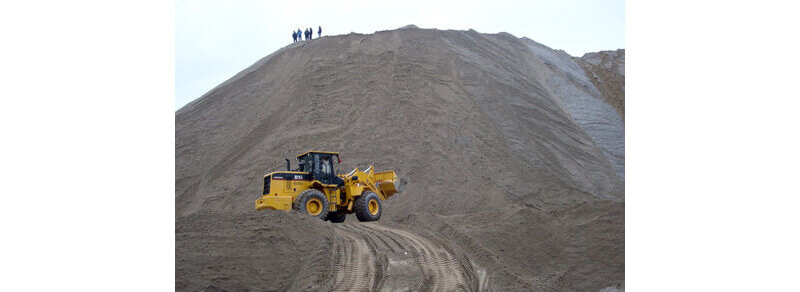What is tungsten tailings?
Tungsten tailings are solid materials formed by dehydration after extracting slurry containing tungsten ore, composed mainly of gangue minerals and surrounding rock, containing fluorite, quartz, garnet, feldspar, mica, calcite, etc. some containing a small amount of polymetallic minerals such as molybdenum and niobium.
How to effectively use tungsten tailings?
Recover useful metals in tungsten tailings such as tin, molybdenum, niobium, copper, lead, zinc, antimony, bismuth, cobalt, gold, silver, etc. It can not only improve the quality of tungsten products, but also make effective use of mineral resources.
The valuable metals currently recovered are mainly tungsten, molybdenum and rhenium.
You may interest in the tungsten ore property and processing methods
Recover tungsten from tungsten tailings
Tungsten tailings scavenging is an effective way to improve the tungsten ore recovery rate.
The recovery of tungsten from tungsten tailings and fine tungsten mud is achieved by a combined metallurgy process, and the recovery rate of WO3 is up to 82.6%.
The flotation method for tungsten ore is extended to tungsten tailings and fine mud, and 18% tungsten crude concentrate of WO3 grade is obtained, and the crude concentrate is directly alkali-decomposed, and the leaching efficiency is remarkably improved.
The micro-bubble technology was used to recover fine-grained scheelite from scheelite flotation tailings, and the recovery rate in the range of 5~38μm was 65%.
The high-gradient magnetic separation was used to recover the wolframite from the scheelite flotation tailings. After one rough selection, one scavenging, and strong magnetic separation, it was found that the 0.43% f WO3 grade wolframite strong magnetic concentrate obtained from the 0.20% WO3 tailings, the tungsten recovery rate of 73.26%.
Molybdenum, bismuth recovery
Many tungsten deposits are associated with varying degrees of molybdenum and bismuth, although some molybdenum and bismuth can be recovered during gravity separation operations, due to the natural floatability of molybdenum and bismuth, it is often floated into the tailings, resulting in a low recovery rate of molybdenum and bismuth.
Tungsten gravity tailings — flotation molybdenum and bismuth directly
Fine mud tailings — concentration first, then flotation
Non-metallic minerals recovery
The non-metallic minerals in tungsten metal are mainly quartz, feldspar, mica, garnet, fluorite, calcite, among them, fluorite and garnet have recovery value.
1 Fluorite
Fluorite is an important non-metallic mineral widely used in chemical, metallurgical and building materials industries. The grade of fluorite ore in China is generally low, and the associated deposits account for 43%. The recovery of fluorite minerals in tungsten tailings is of great significance.
2 Garnet
Garnet is a weak magnetic mineral with high hardness and chemical stability. It is mainly used in abrasives, building materials and polymer fillers. The garnet ore grade is not high, and the industrial-grade requirement is more than 14%. It is the basis of deep processing of garnet by magnetic separation and gravity to increase the garnet grade.
Tungsten tailings for building materials
The main components of tungsten tailings are oxides of silicon and aluminum, which are similar to traditional building materials. In addition, tungsten tailings are finer and do not need to be crushed, which has the advantages of low energy consumption and low cost.
1 Tungsten tailings for the cement industry
The use of tungsten tailings as a raw material for the production of cement can reduce the amount of fluorite. When the mass fraction of WO3 in raw meal is 1×10~6×10, it can improve the burnability of raw materials and is beneficial to the formation of cement clinker mineral Elite. The escape rate of tungsten is almost zero, and it can reduce the escape of lead, mercury and fluorine, and can be used as an environmentally friendly cement clinker mineralizer.
The use of tungsten tailings as a raw material for cement clinker reduces the pollution of fluorine sulphur.
However, tungsten tailings are used as raw materials for the production of cement to control the amount of addition, and excessive amounts may cause side effects.
2 Tungsten tailings for glass-ceramics
Glass-ceramic is a new building material with high brightness and toughness. As early as the early 1960s, the former Soviet Union carried out research and production of glass-ceramics for tailings preparation, and later developed in many countries and formed large-scale production.
Tungsten glass-ceramics prepared by the cast-forming method using tungsten tailings as the main raw material without adding crystal nucleating agent, simple and low cost, the main crystal phase of which is β-wollastonite, and its nucleation and crystallization mechanism belongs to surface nucleation and crystallization.
3 Other applications of tungsten tailings
In addition to the above applications, tungsten tailings are also used in other applications such as bioceramics, mineral polymeric materials, ceramic tiles, and the like.
The tungsten tailings are used as raw materials, and the slag, fly ash and clay are used as auxiliary materials, and the porous bioceramic filter material can be produced by roasting.
Tungsten tailings and metakaolin are the main raw materials, and water glass and NaOH are alkali activators to produce mineral polymeric materials.
It is also possible to use tungsten flotation tailings as raw material to produce ceramic tiles, which can effectively reduce the firing temperature and reduce the production cost.
At present, the domestic reserves of tungsten resources are declining year by year, the grade of raw ore is getting lower and lower, and tungsten tailings resources are recovered from valuable metals and non-metallic minerals, which can effectively improve resource utilization.
JXSC has 35 years of experience in the mining industry, we produce mining equipment, design processing flowchart for customers.
Mining equipment: jaw crusher, cone crusher, impact crusher, hammer crusher, roller crusher, vibrating feeder, vibrating screen, gravity separator, flotation machine, magnetic separator, conveyor belt.
LATEST PRODUCTS
Twin Screw Feeder
【Feeding Capacity】 10-160 t/h【Power】 2.2-…
Tubular Screw Conveyor
【Capacity】6-50 m3/h【Procesible Material】 …
Heavy Plate Feeder
Capacity: 100-240 m3/h Power: 15-45 kW Speed: 0…










